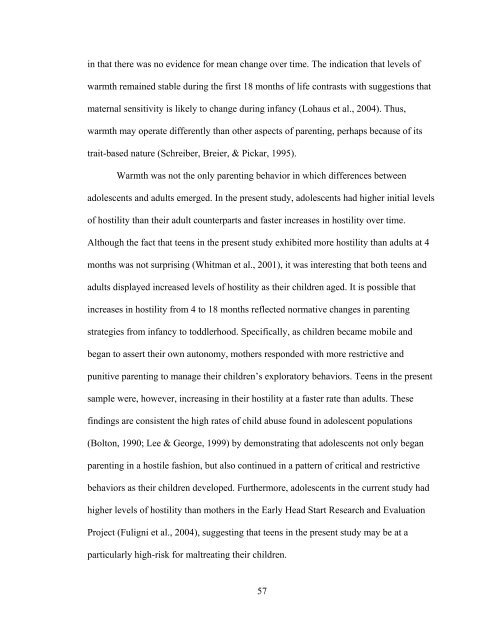DIFFERENCES BETWEEN ADOLESCENT AND ADULT MOTHERS ...
DIFFERENCES BETWEEN ADOLESCENT AND ADULT MOTHERS ...
DIFFERENCES BETWEEN ADOLESCENT AND ADULT MOTHERS ...
Create successful ePaper yourself
Turn your PDF publications into a flip-book with our unique Google optimized e-Paper software.
in that there was no evidence for mean change over time. The indication that levels of<br />
warmth remained stable during the first 18 months of life contrasts with suggestions that<br />
maternal sensitivity is likely to change during infancy (Lohaus et al., 2004). Thus,<br />
warmth may operate differently than other aspects of parenting, perhaps because of its<br />
trait-based nature (Schreiber, Breier, & Pickar, 1995).<br />
Warmth was not the only parenting behavior in which differences between<br />
adolescents and adults emerged. In the present study, adolescents had higher initial levels<br />
of hostility than their adult counterparts and faster increases in hostility over time.<br />
Although the fact that teens in the present study exhibited more hostility than adults at 4<br />
months was not surprising (Whitman et al., 2001), it was interesting that both teens and<br />
adults displayed increased levels of hostility as their children aged. It is possible that<br />
increases in hostility from 4 to 18 months reflected normative changes in parenting<br />
strategies from infancy to toddlerhood. Specifically, as children became mobile and<br />
began to assert their own autonomy, mothers responded with more restrictive and<br />
punitive parenting to manage their children’s exploratory behaviors. Teens in the present<br />
sample were, however, increasing in their hostility at a faster rate than adults. These<br />
findings are consistent the high rates of child abuse found in adolescent populations<br />
(Bolton, 1990; Lee & George, 1999) by demonstrating that adolescents not only began<br />
parenting in a hostile fashion, but also continued in a pattern of critical and restrictive<br />
behaviors as their children developed. Furthermore, adolescents in the current study had<br />
higher levels of hostility than mothers in the Early Head Start Research and Evaluation<br />
Project (Fuligni et al., 2004), suggesting that teens in the present study may be at a<br />
particularly high-risk for maltreating their children.<br />
57
















